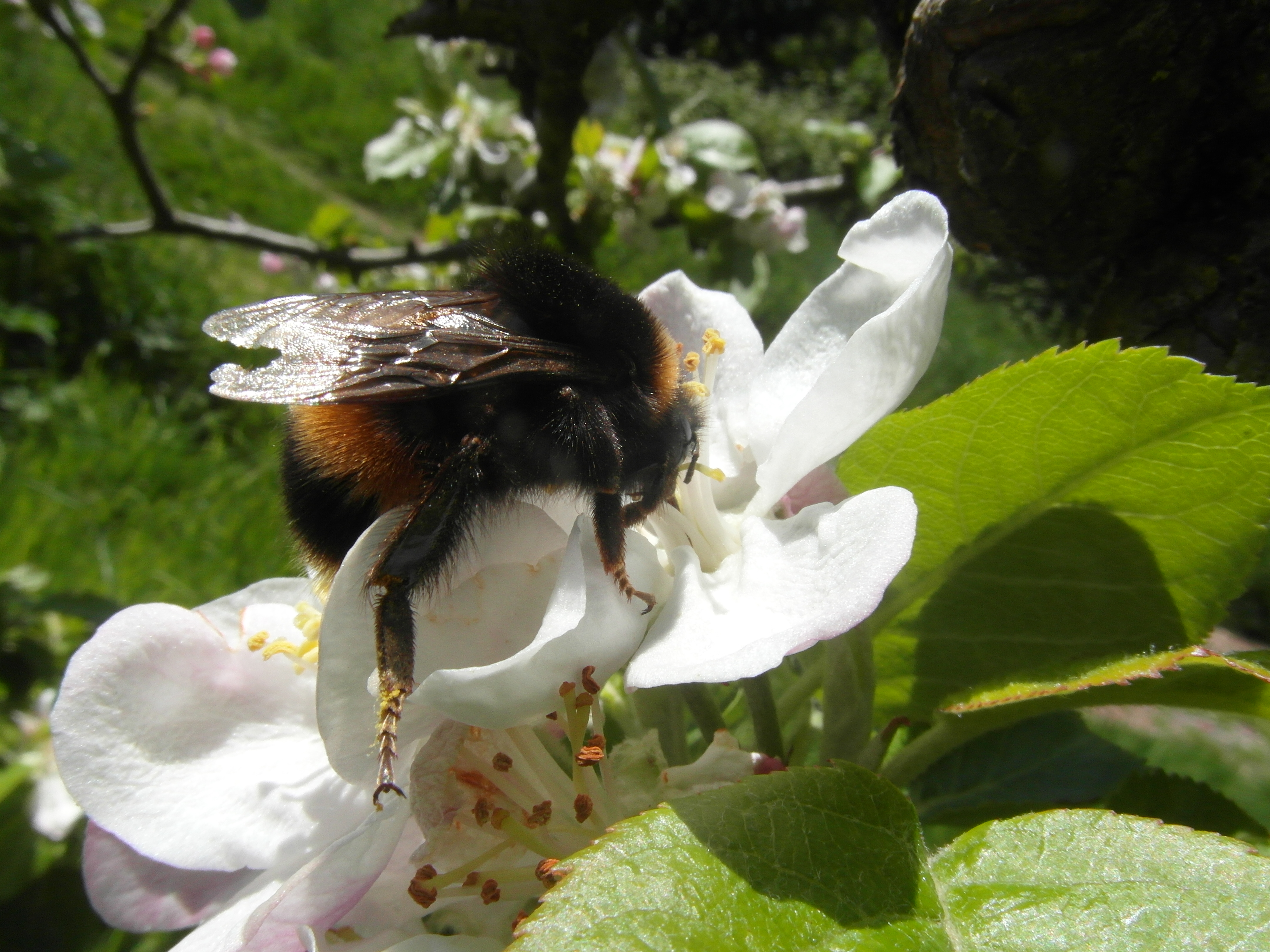Find out how some simple, low cost measures can help turn your orchard into a wildlife haven. Which wildlife tip could you use to help biodiversity in your orchard?
Orchard wildlife tip #1 – Plant new trees
Planting new trees is just as important as retaining old ones and will ensure a succession of habitats for a variety of species. Planting young trees ensures continuity over time to help provide a stable habitat.
As the trees in your orchard age and die, plan to replace them with the next generation. These can be produced from grafts of existing trees which may help to preserve old and local varieties.
- + More info about planting new trees
Planting ‘standard’ trees
Standard trees are grown on vigorous root-stocks and can make full or near full sized trees. Planting standard trees rather than using dwarfing root-stocks, extends the trees’ life expectancy and enables traditional management such as grazing or cutting for hay. Standards have a particular way of ageing that make them great for biodiversity. As they age they form rot holes that create perfect natural nesting sites for birds and bats and other animals. They develop hollow trunks with a fantastic decomposing wood habitat for fungi and beetle larvae, which can in turn provide good forage for birds like woodpeckers.
Even though standards can grow to full sized trees, formative pruning can be used to restrict their height and shape. These have the advantage of still making veteran trees. Dwarfing and semi-dwarfing trees do not offer the same conditions as they have shorter lifespans and a different pattern of age decay.
Keep old varieties going
You can keep old varieties going (even if you are not sure what they are) by grafting scions from them onto new root-stock to plant in your orchard. Fruit trees don’t live forever but this is a great way to make sure that the diversity of cultivars is retained when an old tree comes to the end of its life.
Plant a mixture of early mid and late flowering and fruiting trees
Fruit blossom begins in early march with different varieties flowering throughout spring. Fruit ripening time also varies between varieties, they are generally grouped into early, mid and late season varieties. Planting a mixture means that your orchard will be a source of nectar, pollen and fruit for longer. This isn’t just great for the wildlife in your orchard, but extends the window you can enjoy the blossom and the fruit.
Broadly speaking, plums will flower in March, pears in April and most apples flower in May. To promote cross-pollination and so good fruit set, all varieties should have at least one other from the same pollination group planted near to them. Even self-fertile varieties will benefit from this.
Visit our practical guides pages for more information about tree planting.
Orchard wildlife tip #2 – Retain dead and decaying wood within your trees
As a tree matures, it will naturally die-back and begin to hollow out enabling it to remain standing, recycle nutrients and ultimately thrive for longer. Decaying and dead wood, therefore, does not necessarily mean that a tree is in poor health. It will still be able to survive and produce fruit for many years to come whilst providing valuable habitat for numerous species.
- + More information about the dead wood habitat
Insect larvae of species like the stag beetle, rhinoceros beetle and the rare noble chafer live exclusively in decaying wood.
Not all dead wood was created equal. The deadwood habitat varies vastly with the size, type and especially positioning of this wood. For example standing dead wood remains dry and decomposes in an entirely different way to non-standing deadwood such as log piles, and to piles of brushwood.
From a wildlife perspective, standing decaying wood is one of the most valuable elements of the orchard habitat. Hollow trunks, cracks in bark and rot holes support a breath-taking range of saproxylic (deadwood-dependent) insects and also provide nesting and roosting areas for birds, bats, dormice and other animals. In fact even a dead tree will be teeming with life for years.
For this reason, also try to keep old or dead trees standing in your orchard as long as possible. It is important to plant new trees when old ones die, but as it is not recommended to plant exactly in the site of an old tree, the old or dead tree can remain in-situ.
Orchard wildlife tip #3 – Log piles
All dead wood provides a great food source for foraging animals like shrews, voles and birds looking for larvae to eat. Small rodents in turn attract owls and other birds of prey to your orchard. Log piles also provide overwintering sites and shelter for animals like frogs, toads, beetles and hedgehogs.
- + More info about log piles
Where unsafe decaying branches must be removed, consider stacking them nearby for the benefit of fungi and insects. If you have space to accommodate a log pile or a brushwood pile, then this will contribute to the range of habitats.
Orchard wildlife tip #4 – Windfall fruit
The fruit from your trees is just as delicious to wildlife as it is to us, and windfalls as well as fruit left on the trees provide an important source of food in the autumn and winter, ensuring the survival of a range of creatures.
- + More info about windfall fruit and wildlife
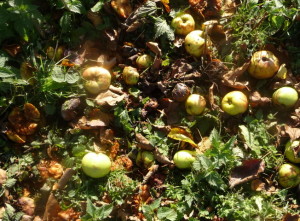
Windfall apples
Overripe fruit feeds birds like field fares, redwings, thrushes and blackbirds and mammals such as badgers, hedgehogs and hares. Decomposing fruit also feeds moths and other insects, providing prey for bats as they prepare for hibernation.
Leave any unwanted fruit to hang on the tree or where it falls, and if you juice apples, leave the leftover ‘scrat’ for foraging wildlife.
Orchard wildlife tip #5 – Grass management
A more varied orchard floor in terms of structure and plant communities will support a greater diversity of insects, small mammals and birds. Ideally you will have areas of long grass as well as areas of short grass, and stagger your mowing regime to accommodate flower seed set times.
- + More info about grass management
Areas of tall grass
Leave an area uncut to provide sites for insects like ladybirds to overwinter. Many insects hibernate in hollow stems. Areas of tall grass are excellent habitats for insects and small mammals. Some species, including the larvae of the butterflies meadow brown and speckled wood, prefer coarse grasses such bents, cock’s-foot, fescues, downy oat-grass and false brome as their larval food-plants
Area of short grass
Keep an area of short grass, which makes a good habitat for grassland fungi and hunting ground for owls.
Low fertility grassland supports a greater diversity of plant species, so avoiding adding any fertilisers to the grassland will help maintain this bio-diverse habitat.
Areas of late cut grass
Staggered and late mowing, as well as leaving a strip of rough grassland will help improve habitat structure and enable the flowering plants to set and disperse seed before being mown. For annual plants this is particularly important so that there is a generation in the next year.
Remove grass cuttings
Remove any grass cuttings from the orchard floor and pile them in an area to compost out of the way. Low fertility grassland supports greater diversity and doing this prevents nutrients being returned to the soil.
Nettles
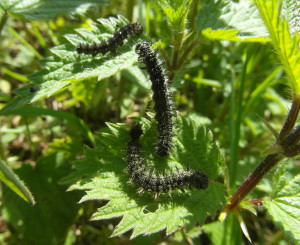
Small tortoiseshell caterpillars on nettle
Leave patches of nettles here and there in your orchard. Nettles are the larval food-plant for species of butterfly including the red admiral, peacock, comma, and small tortoiseshell, as well as other invertebrates.
Although you don’t want nettles all through your orchard, their value to biodiversity is significant.
There is more information about grass management on our practical guides pages.
Orchard wildlife tip #6 – Hedgerows
Hedgerows can really boost the biodiversity in an orchard, providing shelter and food, and acting as a corridor, connecting up other habitats, allowing the movement of animals across the countryside. Many hedgerow species provide additional sources of nectar in the summer and fruit in the autumn and winter.
- + More information about hedgerows and wildlife
A hedgerow is essentially a linear woodland edge and although many of the associated plants are woodland species, there are a number of native plants that are strongly associated with the hedge habitat. Their structural diversity helps hedgerows support a great diversity of other species.
Hedgehogs use them for nesting and a safe path to travel, bees and other pollinating insects use them for their abundance and longevity of available forage, stag beetles can be found within their deadwood stumps, birds nest and feed within them and bats use them when travelling between roosting and feeding sites, to name but a few creatures that rely on this habitat.
However, hedges often need management to maintain their size and structure. Here are a few simple tips for hedge management to help maintain their value for wildlife.
Avoid cutting your hedge every year
Most trees and shrubs flower and fruit on year old twigs which annual cutting would remove, this removes a food supply for a large variety of animals. For the same reason, when cutting your hedges don’t cut all of them in the same year, instead try staggering it. This will ensure that there is always suitable habitat for wildlife that relies on uncut hedges. Generally speaking, the bigger the hedge, the more wildlife it will be able to support, so leaving a few years between each cut can have a real impact on wildlife.
Don’t cut your hedge in nesting season
Almost all hedgerows will have birds nesting in them, and you should not cut your hedge in the breeding season (1st March to 31st July). The recommended time of year to do any work cutting hedges is January and February. All wild birds, their eggs and active nests are protected by law.
Orchard wildlife tip #7 – Scrub
Scrub is an intermediate habitat between grassland and woodland, generally characterised by shrub vegetation and young trees. It is the vegetation you get when you have no active grassland management. It is great for nesting birds, insects and harvest mice and adds another piece to the orchard mosaic habitat.
- + More information about scrub and orchard wildlife
Whilst a low level of scrub can be good for biodiversity, it will encroach on your orchard if not managed. If you have space to accommodate it, leave a strip of grassland, ideally next to a hedge, to revert to scrub. This will need cutting back every few years, but no other management.
Brambles
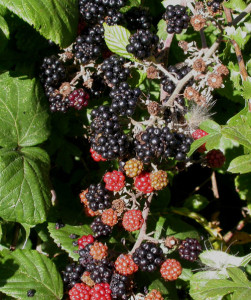 Bramble is a brilliant example of a plant that thrives in hedgerows and scrub areas that contributes hugely to biodiversity. It provides a late source of nectar from July when many other sources have gone over, this benefits insects such as lacewings, bumblebees, honey bees, hover-flies, butterflies and moths. The abundance of insect visitors they attract encourages spiders to make webs and provides food for insect eating birds.
Bramble is a brilliant example of a plant that thrives in hedgerows and scrub areas that contributes hugely to biodiversity. It provides a late source of nectar from July when many other sources have gone over, this benefits insects such as lacewings, bumblebees, honey bees, hover-flies, butterflies and moths. The abundance of insect visitors they attract encourages spiders to make webs and provides food for insect eating birds.
Bramble acts as the food-plant for moth species such as the peach blossom, fox moth and buff arches. It then provides a bounty of blackberries for wildlife in late summer and autumn and the dense thorny vegetation provides predator protection to small mammals and birds like robins, thrushes, finches, wrens and blackbirds.
Orchard wildlife tip #8 – Rot holes and nesting sites
Birds and bats nest in tree hollows, so retain the standing dead wood in your old trees and manage hedgerows with this in mind.
- + More info about wildlife nesting sites
In a young orchard there will be limited natural nesting sites, so consider putting up bird and bat boxes until your trees start to develop these useful veteran features. In larger orchards or if the wider landscape is suitable, you could include barn own or little owl boxes. If old trees are removed or die consider keeping as much of the main trunk as practicable to decay in-situ. Remove lateral boughs to with a foot or two of the trunk so that no heavy unsafe limbs are likely to break off. Make your cuts at such an angle as to exclude rainwater ingress and cap any holes directly exposed to the sky using something like a disk of wood, roofing felt, or old tiles. The dryer the internal wood stays the longer the habitat will persist and the longer the tree will remain standing providing the special dry deadwood resource, roosting sites and nest holes. This also gives time for the soil beneath the tree to rest and rejuvenate so should reduce the possibility of replant disease if replanting in the same spot.
Orchard wildlife tip #9 – Orchard pest management
A biodiverse ecosystem is more robust, and less prone to dramatic population increases of any single species. This is useful when it comes to controlling pest species in your orchard, which are unlikely to multiply to damaging population sizes in a species rich habitat.
- + More about pest management and wildlife
Using pesticide sprays on your orchard kills insect species indiscriminately and this reduction in insect life impacts other animals like bats and birds further along the food chain, as well as the overall health of your orchard.
The species that act as pests in our orchards have natural predators and parasites. These ‘natural enemies’ of pests can play an important role in regulating pest populations. For example, outbreaks of the pest red spider mite are only a problem in commercial orchards, rarely occurring in un-sprayed orchard habitats. One way of reducing pest damage therefore is to create an orchard habitat that encourages biodiversity and these natural enemies. In fact, in recognition of this, biological control is now being used in increasing frequency in commercial orchards.
Looking to biodiversity to control pest problems also means you are not damaging non-target species by accident, such as honey bees. These, as well as other pollinating insects, are absolutely necessary in orchards to pollinate the blossom and ensure a good crop.
Orchard wildlife tip #10 – Mistletoe
Orchard trees are often host to the semi-parasitic plant mistletoe. Although too much mistletoe can damage apple trees, healthy trees can easily support small quantities. These plants are not only an important source of berries for birds such as mistle thrushes and blackcaps, but form the basis of a small ecosystem of its own. The specialist fauna comprises one moth, one weevil and four bugs, three of which feed on the plant and the fourth is a predator of the other bugs.
Remove any large clumps from the top of the canopy as these can lead to windthrow in the winter when the ground is soft and no other foliage is present as a wind-break.
Orchard wildlife tip #11 – Ivy
Ivy growing up trees is not parasitic, it uses its stem roots to cling onto the tree for support, however if it is growing heavily on a weak or damaged tree the extra weight can be enough to cause damage. Although there are differing opinions about the damage ivy can do to trees, its benefit to local biodiversity is indisputable.
- + More information about ivy and wildlife
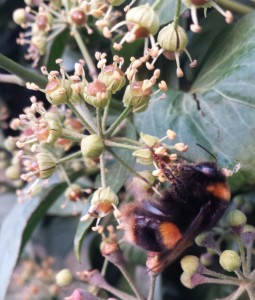
Bumblebee on ivy flowers by Joanna Durant
Ivy flowers in September and October, meaning it provides nectar to butterflies and bees when most other flowers have gone over. Ivy flowers are so good for pollinators that it even has its own species of bee, the ivy bee, that feeds only on ivy flowers. Ivy fruits persist on the plant through winter and into spring, when the high-energy berries provide food for wood pigeons, thrushes, blackbirds, redwings and small mammals. Not only this but the thick layer of vegetation over tree trunks creates the perfect habitat for nesting animals, hibernating animals and for insects all year round.
